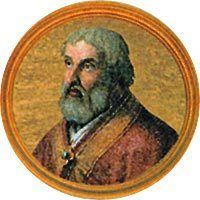Papacy began 31 July 1009 Papacy ended 12 May 1012 | Name Pope IV Consecration 1004 Created cardinal 1004 | |
 | ||
Birth name Pietro Martino Buccaporci Previous post Cardinal-Bishop of Albano (1004–1009) Similar People Pope John XVII, Pope Theodore II, Pope Honorius II, Pope Clement III, Pope Celestine II | ||
Pope sergius iv
Pope Sergius IV (970 – 12 May 1012) was Pope and the ruler of the Papal States from 31 July 1009 to his death in 1012.
Contents
- Pope sergius iv
- Pope Sergius IV Wikipedia audio article
- Early life
- Papal election
- Pontificate
- Death and legacy
- References

He was born in Rome as Pietro Martino Buccaporci, which essentially translates as "Peter Martin Pig's Snout." The date of his birth is unknown but is believed to be around 970.
Pope Sergius IV | Wikipedia audio article
Early life
Buccaporci was the son of a shoemaker also by the name of Pietro. Despite his family's poor background, he performed well after entering the Church and rose quickly through the ranks. In 1004, he became the Cardinal-Bishop of Albano after he became a cardinal.
Papal election
He was elected pope after the abdication of Pope John XVIII in 1009, and adopted the name Sergius IV.
Pontificate
The power held by Sergius IV was small and often overshadowed by John Crescentius III, the ruler of the city of Rome at the time. Some historians have claimed that Sergius IV was essentially a puppet ruler for Crescentius III. Others, however, claimed that the Pope resisted his power, and there is some evidence that Sergius IV gave political backing to an anti-Crescentius, German faction in the city.
Acts sometimes attributed to Sergius IV include measures to relieve famine in the city of Rome, and the exemption of certain monasteries from episcopal rule. A papal bull calling for Muslims to be driven from the Holy Land after the Church of the Holy Sepulchre was destroyed in 1009 by the Fatimid caliph al-Hakim bi-Amr Allah has been attributed to him, although its authenticity has long been a matter of debate. Carl Erdmann considered it genuine, but it was rejected at length by Aleksander Gieysztor, who suggested that it was actually invented around the time of the First Crusade in order to help justify that expedition to Jerusalem. More recently, Hans Martin Schaller has forcefully argued for the document's authenticity.
Death and legacy
Sergius IV died on 12 May 1012 and was buried in the Archbasilica of St. John Lateran, and although not canonized is sometimes venerated as a saint by the Benedictines of which he was a member. There was some suspicion that he was murdered, as he died within a week of Crescentius, considered by many to have been his patron. Sergius was followed in the papacy by Pope Benedict VIII.
